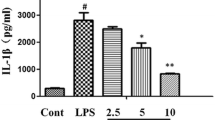Abstract
Amentoflavone, a biflavonoid with antiinflammatory activity, downregulates COX-2 expression in TNFα-activated A549 cells with concomitant inhibition of NF-κB mediated signaling cascades. We demonstrate here that amentoflavone inhibits NF-κB/DNA binding activity potently along with inhibition of degradation of IκBα and NF-κB translocation into nucleus in TNFα-activated A549 cells. This flavonoid upregulates PPAR γ, a transcription factor involved in repressing many cytokine-induced gene expressions. Hence amentoflavone, a dietary constituent, may be of therapeutic value for several lung diseases where COX-2 plays an important role.
Similar content being viewed by others
References
Baeuerle PA, Baltimore D: NF-kappa B: Ten years after. Cell 87: 13–20, 1996
Verma IM, Stevenson JK, Schwartz EM, Van Antwerp D, Miyato, S: Rel/NF-kappa B family: Intimate tales of association and dissociation. Genes Dev 9: 2723–2735, 1995
Ferrandiz ML, Alcaraz MJ: Anti-inflammatory activity and inhibition of arachidonic acid metabolism by flavonoids. Agents Actions 32: 283–288, 1991
Plaumann B, Fritsche M, Rimpler H, Brandner G, Hess RD: Flavonoids activate wild-type p53. Oncogene 13: 1605–1614, 1996
Middleton E Jr, Kandaswami C: In: J.H. Harborne, A.R. Liss (eds). The Flavonoids: Advances in Research Since 1986. Chapman and Hall, New York, 1994, pp 619–652
Konig A, Schwartz GK, Mohammad RM, Al-Katib A, Gabrilove JI: The novel cyclin-dependent kinase inhibitor flavopiridol down regulates Bcl-2 and induces growth arrest and apoptosis in chronic B-cell leukemia lines. Blood 90: 4307–4312, 1997
Fotsis T, Pepper MS, Aktas E, Breit S, Rasaku S, Adler-crentz H, Wahala K, Montesano R, Schweigener L: Flavonoids, dietary-derived inhibitors of cell proliferation and in vitro angiogenesis. Cancer Res 57: 2916–2921, 1997
Cao G, Sofie E, Prior R: Antioxidant and prooxidant behavior of flavonoids: Structure-activity relationships. Free Radic Biol Med 22: 749–760, 1997
Breinholt V, Larson JC: Detection of weak estrogenic flavonoids using a recombinant yeast strain and modified MCF7 cell proliferation assay. Chem Res Toxicol 11: 622–629, 1998
Liang YC, Huang YC, Tsai SH, Lin-Shian SY, Chen CF, Lin JK: Suppression of inducible cyclooxygenase and inducible nitric oxide synthase by apigenin and related flavonoids in mouse macrophages. Carcinogenesis 20: 1945–1952, 1999
Segaert S, Courtois S, Garmyn M, Degreef H, Bouillon, R: Vitamin D receptor expression is linked to cell cycle control in normal human keratinocytes. Biochem Biophys Res Commun 268: 237–241, 2000
Saliou C, Rihn B, Cillard J, Okamoto T, Packer L: Selective inhibition of NF-κB activation by the flavonoid hepatoprotector silymarin in HepG2. FEBS Lett 440: 8–12, 1998
Kim HK, Son KH, Chang HW, Kang SS, Kim HP: Amentoflavone, a plant biflavone: A new potential anti-inflammatory agent. Arch Pharm Res 21: 406–410, 1998
Lin YM, Flavin MT, Schure R, Chen FC, Sidwell R, Barnard DL, Huffman JH, Kern ER: Antiviral activities of biflavonoids. Planta Med 65: 120–125, 1999
Lin LC, Kuo YC, Chou CJ: Cytotoxic biflavonoids from Selaginella delicatula. J Nat Prod 63, 627–630, 2000
Lee HS, Oh WK, Kim BY, Ahn SC, Kang DO, Shin DI, Kim J, Mheen TI, Ahn JS: Inhibition of phospholipase Cγ1 activity by amentoflavone isolated from Selaginella tamariscina. Planta Med 62: 293–296, 1996
Kim HP, Mani I, Iversen L, Ziboh VA: Effects of naturally-occurring flavonoids and biflavonoids on epidermal cyclooxygenase and lipoxygenase from guinea-pigs. Prostaglandins Leukot Essent Fatty Acids 58: 17–24, 1998
Delerive P, Gervois P, Fruchart JC, Staels B: Induction of Ikappa-Balpha expression as a mechanism contributing to the anti-inflammatory activities of perioxisome proliferator-activated receptor-alpha activators. J Biol Chem 275: 36703–36707, 2000
Marx N, Sukhova GK, Collins T, Libby P, Plutzky J: PPARalpha activators inhibit cytokine-induced vascular cell adhesion molecule 1 expression in human endothelial cells. Circulation 99: 3125–3131, 1999
Liang YC, Tsai SH, Tsai DC, Lin-Shiau SY, Lin JK: Suppression of inducible cyclooxygenase and nitric oxide synthase through activation of perioxisome proliferator-activated receptor-γ by flavonoids in mouse macrophages. FEBS Lett 496: 12–18, 2001
Poynter ME, Daynes RA: Peroxisome proliferator-activated receptor alpha activation modulates cellular redox status, represses nuclear factor kappaB signaling, and reduces inflammatory cytokine production in aging. J Biol Chem 273: 32833–32841, 1998
Rosette C, Karin M: Cytoskeletal control of gene expression depolymerization of microtubules activates NF-kappaB. J Cell Biol 128: 1111–1119, 1995
Berger R, Duncan MR, Berman B: Nonradioactive gel mobility shift assay using chemiluminescent detection. Biotechniques 15: 650–652, 1993
Duncan MR, Hasan A, Berman B: Pentoxyfylline, pentifylline and interferons decrease type I and III procollagen mRNA levels in dermal fibroblasts: Evidence for mediation by nuclear factor 1 down-regulation. J Invest Dermatol 104: 282–286, 1995
Demczuk S, Harbers M, Vennstrom B: Identification and analysis of all components of a gel retardation assays by combination with immunoblotting. Proc Natl Acad Sci USA 90: 2574–2578, 1993
Tsai SH, Lin-Shiau SY, Lin JK: Suppression of nitric oxide synthase and the down-regulation of the activation of NF-κB in macrophage by resveratrol. Br J Pharmacol 126: 673–680, 1999
Canicio J, Ruiz-Lozano P, Carrasco M, Palacin M, Chien K, Zorzano A, Kaliman P: Nuclear factor κB-inducing kinase and IκB kinase – α signal skeletal muscle cell differentiation. J Biol Chem 23: 20228–20233, 2001
Houseknecht KL, Bidwell CA, Protocarrero CP, Spurlock ME: Expression of cDNA cloning of porcine peroxisome proliferator-activated receptor gamma. Gene 225: 89–96, 1998
Zabel U, Baeuerle PA: Purified human I kappa B can rapidly dissociate the complex of the NF-kappa B transcription factor with its cognate DNA. Cell 61: 255–265, 1990
Arenzana-Seisdedos F, Thompson J, Rodriguez MS, Bachelerie F, Thomas D, Hay RT: Inducible nuclear expression of newly synthesized I kappa B alpha negatively regulates DNA-binding and transcriptional activities of NF-kappa B. Mol Cell Biol 15: 2689–2696, 1995
Karin M: The regulation of AP-1 activity by mitogen-activated protein kinases. J Biol Chem 270: 16483–16486, 1995
Li JJ, Westergaard C, Ghosh P, Colburn NH: Inhibitors of both nuclear factor-kappaB and activator protein-1 activation block the neoplastic transformation response. Cancer Res 57: 3569–3576, 1997
Author information
Authors and Affiliations
Rights and permissions
About this article
Cite this article
Banerjee, T., Valacchi, G., Ziboh, V.A. et al. Inhibition of TNFα-induced cyclooxygenase-2 expression by amentoflavone through suppression of NF-κB activation in A549 cells. Mol Cell Biochem 238, 105–110 (2002). https://doi.org/10.1023/A:1019963222510
Issue Date:
DOI: https://doi.org/10.1023/A:1019963222510




